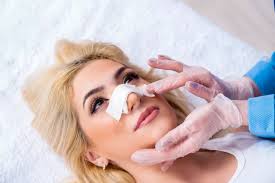Rhinoplasty, commonly referred to as a nose job, is a popular cosmetic surgery aimed at improving the appearance or function of the nose. While the procedure can yield dramatic results, the recovery process is crucial for achieving the best outcomes. If you are considering rhinoplasty in dubai, understanding the recovery process and knowing how to manage it effectively will help ensure a smooth healing journey. This guide provides essential tips and insights for patients to navigate the recovery phase successfully.
Understanding the Recovery Timeline
The recovery period following rhinoplasty varies among individuals, but there are general stages to anticipate:
First Week:
The initial recovery phase involves significant swelling and bruising. The nasal splint, typically applied during surgery, remains in place for about a week. During this time, you will likely experience discomfort and congestion.
Two to Four Weeks:
Swelling begins to subside, and bruising fades. Many patients feel more comfortable and can return to work or daily activities, but vigorous physical activities should still be avoided.
One to Three Months:
Residual swelling continues to decrease. You may notice gradual changes in the shape of your nose as the tissues heal and settle.
Six to Twelve Months:
The final results become more apparent as the nose's shape stabilizes and all residual swelling dissipates.
Follow Post-Operative Instructions
Adhering to your surgeon's post-operative instructions is critical for a successful recovery. These instructions may include:
Medication:
Take prescribed medications as directed to manage pain and prevent infection. Avoid over-the-counter medications, especially those that can increase bleeding, such as aspirin or certain anti-inflammatory drugs.
Nasal Care:
Keep the nasal area clean and avoid touching or blowing your nose forcefully. Use saline sprays or prescribed nasal rinses to keep the nasal passages moist and clean.
Sleeping Position:
Sleep with your head elevated to minimize swelling. Avoid sleeping on your stomach or sides, as this can affect the healing process.
Manage Swelling and Bruising
Swelling and bruising are common after rhinoplasty, but there are steps you can take to manage them:
Cold Compresses:
Apply cold compresses or ice packs to the areas around your eyes and nose to reduce swelling and bruising. Be sure to use a cloth or towel between the ice and your skin to prevent frostbite.
Hydration and Nutrition:
Drink plenty of water and maintain a balanced diet rich in vitamins and minerals to support the healing process. Foods high in vitamin C, such as oranges and strawberries, can help with tissue repair.
Avoid Heat:
Stay away from hot environments, such as saunas or hot baths, as heat can exacerbate swelling.
Avoid Physical Activities
Physical activity can impact your recovery, so it’s important to avoid strenuous exercises and activities during the initial healing period:
Exercise:
Refrain from vigorous exercise and heavy lifting for at least six weeks. Gentle activities like walking can be resumed as advised by your surgeon.
Facial Expressions:
Minimize activities that involve excessive facial expressions, such as laughing or talking loudly, as these can strain the healing tissues.
Protect Your Nose
Protecting your nose from injury is vital for a successful recovery:
Avoid Trauma:
Be cautious to avoid bumping or hitting your nose. This includes protecting it from accidental contact with objects or during activities.
Sunglasses:
Avoid wearing glasses or sunglasses that rest on the bridge of your nose until your surgeon gives the go-ahead. If necessary, use a band to secure them in place without touching your nose.
Attend Follow-Up Appointments
Regular follow-up appointments with your surgeon are essential to monitor your healing progress:
Examinations:
Your surgeon will assess the healing of your nose, remove any nasal packing, and adjust the nasal splint if needed.
Communication:
Inform your surgeon of any concerns or unusual symptoms, such as excessive bleeding, severe pain, or signs of infection.
Embrace Patience
The final results of rhinoplasty may not be immediately visible. It’s important to be patient and understand that the nose will undergo gradual changes as it heals:
Initial Results:
While you may notice changes in the shape of your nose soon after the splint is removed, the final shape may not be apparent until several months after surgery.
Long-Term Healing:
Complete healing and the final contour of your nose may take up to a year. During this time, avoid comparing your nose to before surgery or to others.
Psychological Well-Being
Recovery from rhinoplasty is not only a physical process but also an emotional one:
Support:
Seek support from friends, family, or a counselor if you experience anxiety or emotional challenges during your recovery.
Self-Care:
Engage in activities that help you relax and stay positive, such as reading, listening to music, or practicing mindfulness.
Special Considerations for Dubai Patients
Dubai offers a range of high-quality medical facilities for rhinoplasty, but there are specific considerations for patients in this region:
Climate:
The hot and humid climate in Dubai can affect your skin and healing process. Stay indoors in air-conditioned environments when possible and protect your skin from sun exposure.
Healthcare Providers:
Choose a reputable clinic or surgeon with experience in rhinoplasty. Ensure that the clinic follows international standards for hygiene and patient care.
Cultural Sensitivity:
Be aware of cultural considerations and discuss any specific needs or preferences with your surgeon. Dubai’s diverse population means there are various approaches to aesthetic preferences, and your surgeon can tailor the procedure to suit your goals.
Conclusion
Rhinoplasty recovery involves careful attention to post-operative care, patience, and proper management of the healing process. By following these essential tips and insights, patients in Dubai can ensure a smoother recovery and achieve the best possible results. Always consult with your surgeon for personalized advice and guidance to navigate your recovery effectively. With the right approach, you can enjoy the aesthetic and functional benefits of rhinoplasty and embrace your new look with confidence.






Comments